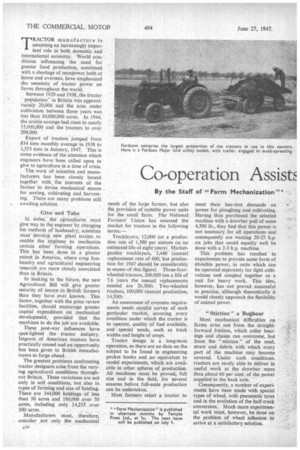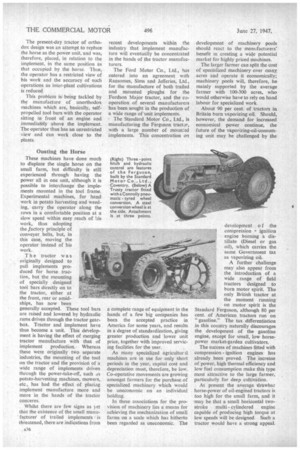Co-operation Assist Power. Farming Development
Page 68

Page 69

Page 70

If you've noticed an error in this article please click here to report it so we can fix it.
By the Staff of "Farm Mechanization "'"
scientists, Manufacturers and Farmers Work Together in Devising and Improving Mechmica' Equipment for Drilling, Cultivating and Harvesting, But Problems Await Solution
TRACTOR manufacture is assuming an increasingly important role in both domestic and international economy. World conditions influencing the need for greater food production, combined with a shortage of manpower both at home and overseas, have emphasized the necessity of tractor power on farms throughout the world.
Between 1929 and 1938, the tractor population.' in Britain was approximately 20,000 and the area under cultivation between those years was less than 10,000,000 acres. In 1944, the arable acreage had risen to nearly 15,000,000 and the tractors to over 200,000.
Export of tractors jumped from .834 tons monthly average in 1938 to 1,553 tons in January, 1947. This is some evidence of the attention which engineers have been called upon to give to agriculture in a time of crisis.
The work of scientists and manufacturers has been closely bound together with, the interests of the farmer -to devise mechanical means for sowing, cultivating and harvesting. There are many problems still awaiting solution.
Give and Take In softie," the' agriculturist must give way to the engineer bY changing his methods of husbandry; scientists must develop new plant strains to enable the engineer to mechanize certain other' farrning operations. This has been done to a greater extent. in America, where crop husbandry and agricultural engineering research are more closely associated than in Britain.
In looking to the future, the new Agricultural Bill will give greater security of tenure to British farmers than they have ever known. This factor, together with the price review facilities, should encourage greater capital expenditure on mechanical development, provided that the machines to do the job'are available.
These post-war influences have spot-lighted the tractor industry. imports of American tractors have practically ceased and an opportunity has been given to British manufacturers to forge ahead.
The greatest problems confronting tractor designers arise from the varying agricultural conditions throughout Britain. These variations are not only in soil conditions, but also in. types of farming and size of holding. There are 344,000 holdings of less than 50 acres and 180,000 over 50 acres, including only 14,235 over 300 acres.
Manufacturers must, therefore, consider not only the mechanical needs of the large farmer, but also the provision of suitable power units for the small farm. The National Farmers' Union has assessed the market for tractors in the following terms:— Tracklayers, 12,000 (or a production rate of 1,500 per annum On an estimated life of eight years). Marketgarden tracklayers, 3,440 (annual replacement rate of 600, but Production for 1947 should be considerably in excess of this figure). Three-fourwheeled tractors, 200,000 (on a life of 7.6 years the annual replacements needed are 26,300). . Two-wheeled tractors, 100,000 (annual production, 14,500).
An assessment of overseas requirements needs careful survey of each particular market, covering every condition under which the tractor is to operate, quality of fuel available, and special needs, such as track widths and height of crops.
Tractor design is a long-term operation, as there are no data on the subject to be found in engineering pocket books and no equivalent to model experiments, which are available in other spheres of production. All machines must be proved, full size and in the field, for several seasons before full-scale production can be undertaken.
Most farmers select a tractor to meet their heaviest demands on power for ploughing and cultivating. Having thus purchased the selected machine with a drawbar pull of some 4,500 lb., they find that this power is not necessary for all operations and consequently are wasting 20-25 h.p. on jobs that could equally well be done with a 2-3 h.p. machine.
This problem has resulted in experiments to provide some 'form of divisible power, in units which can be operated separately for light cultivations and coupled together as a unit for heavy work. This idea, however, has not proved successful in practice, although theoretically it would closely approach the flexibility of animal power.
" Stiction" a Bugbear
Most mechanical difficulties on farms arise not from the straightforward friction, which roller bearings and chains can overcome, but from the " stiction of the mud, straw and debris with which every part of the machine may become covered. Under such conditions, tractors are rarely able to deliver in useful work at the drawbar more than about 60 per cent, of the power supplied to the back axle.
Consequently, a number of experiments have been made with special types of wheel, with pneumatic tyres and in the evolution of the half-track conversion. Much more experimental work must, however, be done on the problem of wheel adhesion to arrive at a satisfactory solution. The present-day tractor of orthodox design was an attempt to replace the horse as the power unit, and was, therefore, placed, in relation to the implement, in the same position as that occupied by the horse. Thus, the operator has a restricted view of his work and the accuracy of such operations as inter-plant cultivations is reduced.
This problem is being tackled by the manufacture of unorthodox machines which are, basically, selfpropelled tool bars with the operator sitting in front of an engine and immediately above the implement. The operator thus has an unrestricted view and can work close to the plants.
Ousting the Horse
These machines have done much to displace the single horse on the small farm, but difficulty is still experienced through having the power all in one unit, although it is possible to interchange the implements mounted in the tool frame. Experimental machines, for hand work in potato harvesting and weeding, carry the operator along the rows in a comfortable position at a slow speed within easy reach of his work, thus adopting the ,factory principle of conveyer belts, but, in this case, moving the operator instead of his work.
h e tractor was originally designed to pull implements produced for horse traction, but the mounting of specially designed tool bars directly on to the tractor, either at the front, rear or amidships, has now been generally accepted. These tool bars are raised and lowered by hydraulic rams driven through the tractor gearbox. Tractor and implement have thus become a unit. This ddveloprrient is having the effect of merging tractor manufacture with that of implement production. Whereas these were originally two separate industries, the mounting of the tool on the tractor and the provision of a wide range of implements driven through the power-take-off, such ...is potato-harvesting machines, mowers, etc., has had the effect of placiag implement manufacture more and more in the hands of the tractor concerns.
Whilst there are few signs as yet that the existence of the small manu • facture! of trailed implements , is threatened, there are indications from recent developments within the industry that implement manufacture will eventually be concentrated in the hands of the tractor manufacturers.
The Ford Motor Co., Ltd., has entered into an agreement with Ransomes, Sims and Jefferies, Ltd., for the manufacture of both trailed and mounted ploughs for the Fordson Major tractor, and the cooperation of several manufacturers has been sought in the production of a wide range of unit implements.
The Standard Motor Co., Ltd., is manufacturing the Ferguson tractor, with a large number of mounted implements. This concentration on a complete range of equipment in the hands of a few big companies has been the accepted practice in America for some years, and results in a degree of standardization, giving greater production and lower unit price, together with improved servicing facilities for the user.
As many specialized agriculturd machines are in use for only short periods in the year, capital cost and depreciation must, therefore, be low. Co-operative movements are growing amongst farmers for the purchase. of specialized machinery which would be uneconomic on an individual holding.
In these associations for the provision of machinery lies a means for achieving the mechanization of small farms on a scale which has hitherto been regarded as uneconomic. The development of machinery pools should react to the mancfacturers. benefit in creating a wide potential market for highly priced machines.
The larger farmer can split the cost of specialized machinery over many. acres and operate it economically; machinery pools will, therefore, be mainly supported by the average farmer with 100-300 acres, who would otherwise have to rely on hand labour for specialized work.
About 90 per cent. of tractors in Britain burn vaporizing oil. Should, however, the demand for increased economical power continue, the future of the vaporizing-oil-consuming unit may be challenged by the development o f the compression ignition engine burning a distillate (Diesel or gas oil), which carries the same Government tax as vaporizing oil.
A further challenge may also appear from the introduction of a wide range of field tractors designed to burn motor spirit. The only British tractor at the moment running on motor spirit is the Standard Ferguson, although 80 per cent. of American tractors run on "gasoline." The tax differentiation in this country naturally discourages the development of the gasoline engine, except for small, low horsepower market-garden cultivators.
The success of machines fitted with compression ignition engines has already been proved. The increase of power, high thermal efficiency and low fuel consumption make this type most attractive to the large farmer, particularly for deep cultivation.
At present the average drawbar horse-power of oil-engined tractors is too high for the small farm, and it may be that a small horizontal twostroke multi cylindered engine capable of producing high torque at low speeds will be designed. Such a tractor would have a strong appeal.




































































































